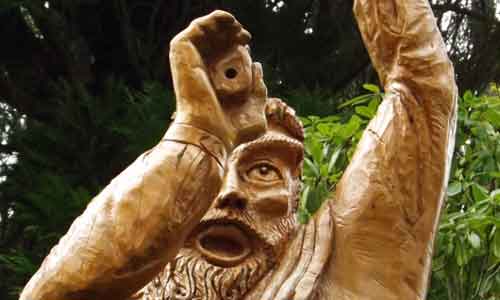FIONA LANG describes how a young Isle of Lewis boy used a small stone with a hole in it to see the future and became the Brahan Seer

A shadowy figure from Scotland’s history, the Brahan Seer is renowned for making a series of bizarre prophecies, many of which came true long after his death.
It is said that he had the gift of second sight and the ability to see into the future through a hole in a stone.
What little we know of him was collected from the Gaelic oral tradition and first published in 1877, at least two centuries after he had lived and died. In those intervening years many conflicting stories had come to be told of him.
Although the Brahan Seer may well have existed in reality, almost everything about him has long ago melted into folklore.
The Second World War, the Highland Clearances, the construction of the Caledonian Canal and the arrival of the railway in the Highlands – he appears to have foretold all of these events and many more. Some believe he even predicted the Piper Alpha disaster of 1988.
Who was the Brahan Seer?
The story goes that sometime in the 16th or 17th century, a young Isle of Lewis boy, Coinneach Odhar, found a small stone with a hole in it.
When he looked through it, he was struck permanently blind in that eye but had acquired the gift of second sight. He spoke prophesies throughout his life, later moving to Brahan, near Inverness, where he earned his living as a wandering labourer. At some point he became known as the Brahan Seer.
An alternative story of how Coinneach came by the stone has it that his mother was tending her cattle one night at her summer sheiling overlooking the Baile-na-Cille graveyard in Uig, Lewis.
Close on midnight she saw the graves opening and the spirits rising up and departing in all directions.
Within the hour they returned and the graves closed. All save one. Curious to know why this one spirit had not returned, Coinneach’s mother barred the opening with her stick and waited.
The spirit who soon tried to enter the grave was a Norwegian princess who had drowned and been washed ashore, far from home. She had returned later than the others, she said, because her journey – to Norway and back – had been longer. In return for being allowed to re-enter her grave, she revealed the location of the seeing stone.
Another version, again based in Norse legend, tells that Coinneach found the stone in a raven’s nest. To obtain a ‘raven stone’, or ‘stone of victory’, you must first steal the eggs of a raven and boil them, then cool them and return them to the nest. After some time, the raven will fly off in search of the Victory Stone, which she will place in her nest to encourage the eggs to hatch. When stolen, the stone will assure victory in battle and give the gift of prophecy.
Yet another story is that, having moved to Brahan, Coinneach fell asleep in the sun while cutting peats. He awoke to find the stone on his chest, and by looking through it he could see that the food brought out to him that day was poisoned. And so the stone saved his life.
Gift of second sight
It is said the gift of second sight brought no happiness. Coinneach’s visions were rarely of anything good, made little sense, and often didn’t seem of much consequence.
He lived into extreme if troubled, old age. Or, alternatively, he was burnt as a witch at Chanonry Point on the Black Isle, by being forced headfirst into a burning barrel of tar through which stakes were then driven. It may be that both versions of his life are true – there may have been more than one Seer, their stories later becoming confused (belief in the gift of second sight was widespread at the time). Two people may have come to be remembered as one.
Shortly before his death, the Brahan Seer is said to have thrown his seeing stone into a lake, claiming that many years in the future it would be found by a ‘lame humpbacked mendicant.’ And by then his prophecies would have come true.
Or in another telling of it, the Brahan Seer threw the stone into a cow’s hoofprint, cursing those who were about to murder him, and declaring that a child with two navels (or in other versions 4 thumbs and 6 toes) would be born. This child would discover the stone inside a fish and so be gifted with prophetic sight. The hoofprint rapidly filled with water, and continued to do so until it became Loch Ussie.
We have no way now of knowing the true events of Coinneach Odhar’s life, or of understanding his extraordinary experience of the world. We can only speculate about his abilities and his beliefs.
As a writer, I feel bound to say that each of the stories woven about the Brahan Seer is as valid as the next. Each one has its own purpose and power. In truth though I like some of them better than others.
A young boy found a stone with a hole in it through which he saw the future. That’s the best story of all right there.
A few of the Brahan Seer’s prophecies:
- ‘When it becomes possible to cross the River Ness dry-shod in five places, a frightful disaster will strike the world.’ (Fulfilled. A fifth bridge was built in the last few days of August,1939. Hitler invaded Poland on September 1st.)
- ‘When nine bridges cross the River Ness, there will be fire, flood and calamity.’ (A ninth bridge was built in 1987. Many people considered the prophecy fulfilled by the Piper Alpha disaster in 1988.)
- ‘The day will come when long strings of carriages without horses shall run between Dingwall and Inverness, and more wonderful still, between Dingwall and the Isle of Skye.’ (Fulfilled by the coming of the railway 1860-1897.)
- ‘Strange as it may seem to you this day, the time will come, and it is not far off, when full-rigged ships will be seen sailing eastward and westward by the back of Tomnahurich, near Inverness.’ (Fulfilled by the construction of the Caledonian Canal 1803-1822.)
- ‘The natural arch, or Clach tholl, near Storehead in Assynt, will fall with a crash so loud as to cause the laird of Leadmore’s cattle, twenty miles away, to break their tethers.’ (Fulfilled, 1841. The laird’s cattle had strayed near the arch, and when it fell they stampeded in panic.)
- ‘A black hornless cow will give birth to a calf with two heads.’ (Fulfilled.)
- ‘The day will come when the Lewsmen shall go forth with their hosts to battle, but they will be turned back by the jaw-bone of an animal smaller than an ass.’ (Surprisingly fulfilled, 1745. Lord Seaforth, who was dining on a sheep’s head at the time, waved the jawbone at his men as he ordered them to return home.)
- ‘The day will come when the Mackenzies of Fairburn shall lose their entire possessions, and that branch of the clan shall disappear almost to a man from the face of the earth. Their castle shall become uninhabited, desolate and forsaken, and a cow shall give birth to a calf in the uppermost chamber in Fairburn Tower.’ (The last of the Mackenzie line died unmarried in 1850. The castle fell into ruin, and a cow calved in the tower, 1851.)
- ‘Sheep shall eat men, men will eat sheep, the black rain will eat all things; in the end old men shall return from new lands.’ (A prophecy as yet unfulfilled, and still feared.)
FIONA LANG is a writer living in the Scottish Highlands, currently working on her second novel. She has a keen interest in cryptozoology and is a lover of all things Fortean and weird. Her blog is www.fionalang.blogspot.co.uk



For the last prophecy, do you think it could have been the highland clearance?